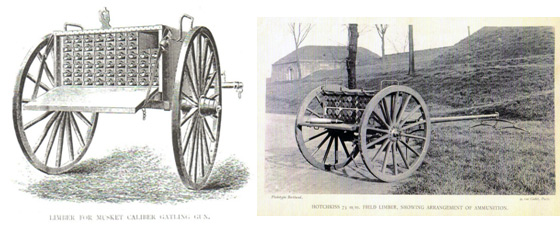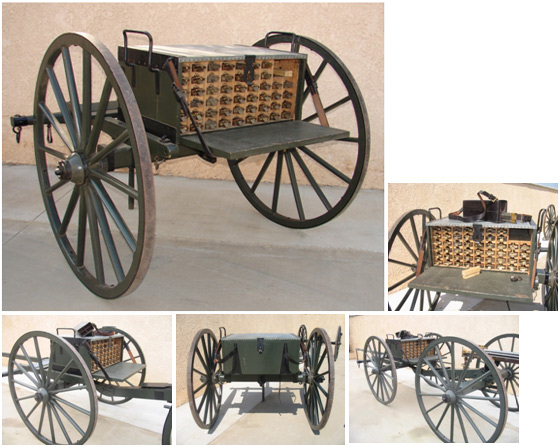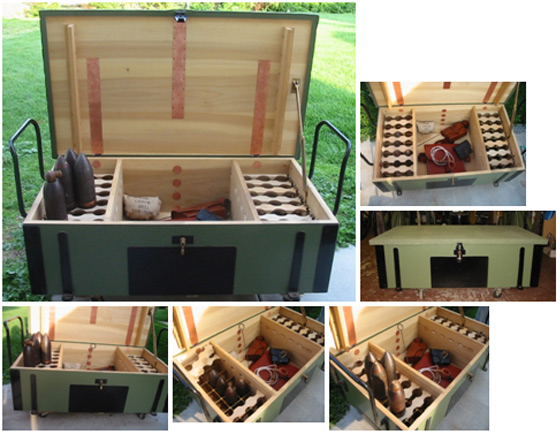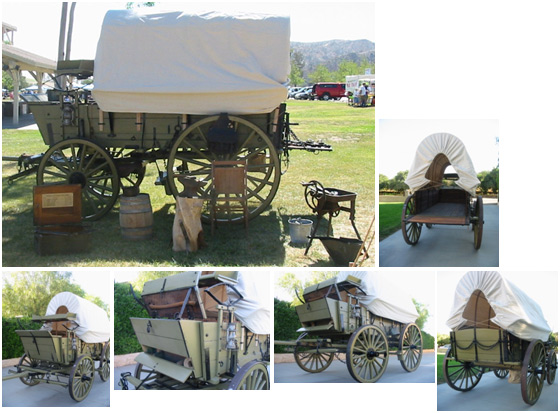Limbers & Wagons
Limbers
The limber was an indispensable piece of equipment. It was a simple two-wheeled cart composed of an axle, with its wheels, surmounted by a framework designed for holding an ammunition chest and receiving the tongue. At the back of the axle is the pintle hook, on which the lunette on the trail of the gun carriage can be keyed into place. The ammunition chest contained the rounds for the artillery pieces. A team of horses was hitched to the limber and an artillery piece was hooked on to its rear when the army was on the move.
The ammunition chest lid was designed to seat the driver. In times of battle, the limber and horses were left behind the lines of fire.

Museum Examples
Gatling Limber
The only peculiarity about this limber, is the manner in which the ammunition is disposed. The back of the limber is a drop-lid, when down, it is supported by a strong leather strap. In this position, the lid serves as a shelf for serving ammunition, and refilling feed-cases. The body of the chest is divided into compartments, fifty for feed cases and one larger for tools or implements, thus giving each limber, a carrying capacity of 2000 rounds.

Revolving Cannon Limber
The upper-half of the chest is constructed for carrying 200 rounds of ammunition placed in a vertical position, the fuse end down and resting in a slight depression reamed out of the floor partition, the upper end being held steady by thin boards perforated with holes the size of the shells, and through the ammunition passes. The lower half of the chest is divided into three compartments. The lower half of the center one holds two case-carriers of leather, provided with leather straps to go over the shoulder. Over this is a drawer containing implements. On either side of the centre compartment is another, holding five galvanized-iron feed cases each carrying 10 rounds, thus giving the chest a carrying capacity of 300 rounds.

3.2 limber Ammunition Chest
This chest is made of wood, ironed, with corrugated-iron plate on back. It is covered with duck, and the lid is secured, when down, by a hasp and turnkey. Three compartments: end ones for projectiles, 21 in each; middle for 44 cartridges and two haversacks. The packing divisions for projectiles are of cast bronze.
Escort Wagon
The Escort Wagon was approved by the Secretary of War November 21, 1878 and built to standardized specifications that allowed for easier interchangeability of components and fewer stocked parts. Drawn by 4 mules or 4 horses, this all-purpose freight wagon replaced the Civil War six-mule wagon. Because there were a number of government-approved suppliers, these wagons are often found with maker’s marks from a variety of builders. Wheels, in particular, are frequently labeled with different maker names. During the 1880’s, the Studebaker Wagon Company highly recommended Archibald wheels for their added strength and reliability.

In 1895 with the end of the long Indian Wars, the War Department greatly reduced its wagon fleet. However, within 3 years, there was a severe shortage as the United States prepared for the Spanish American War. Escort Wagon bodies became cargo beds for some of the earliest trucks in the Mexican Punitive Expedition, as manufacturers were scrambling to provide vehicles to aid Pershing.
Museum Example
1898 Army Escort Wagon
The standard load for the Escort Wagon was 3,000 pounds. When road conditions were dry and flat, a load of 5,000 pounds was often carried. The Escort wagon provided continuous service with little alteration from it's original design well into the 1930's. The Escort Wagon and the Six-Mule Wagon were never replaced. Both wagons served together until the automobile made them obsolete.
Click on image to show enlarged wagons.













